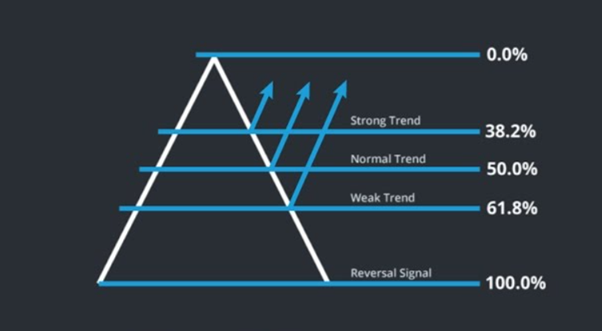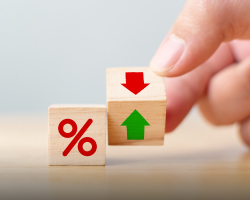Fibonacci Retracement Levels in Forex Trading

Fibonacci levels are one of the most universal and widespread tools, which beginners and experienced traders use for trading forex and other markets. It is widely known that market prices tend to gravitate towards levels where the greatest volume of market orders is accumulated. There are several techniques for detecting and predicting such levels.
Trading systems are based on various levels. Fibonacci levels have been used in trading for a long time - as soon as traders saw that price fluctuation of certain assets often repeat the Fibonacci number sequence clearly enough. The tool is so effective that it is included in the standard MetaTrader 4 trading platform, which is currently the most popular and in demand.
Leonardo Fibonacci lived in ancient Italy and found a simple numeric sequence, which is used everywhere and is universal for a great number of natural phenomena.
The sequence looks like this: 0, then 1, then 1 (0+1), then 2 (1+1), after 3 (1+2), then 5 (2+3), 8 (3+5), etc. Thus, it turns out that the Fibonacci sequence is the sum of the two preceding numbers.
These numbers make it possible to determine an interesting proportion: if the first one is divided by the second one, you get 0.618 (regardless of which of the numbers in the sequence are taken). And if you divide the numbers by one, you get 0.382. These fractions are called the golden ratio, and they occur very often in nature - a striking example is a spiral (like the seeds in a sunflower).
The Fibonacci correction levels in trading look as follows: 0.236, 0.382, 0.500, 0.618, 0.764.
Expansion levels: 0, 0.382, 0.618, 1.000, 1.382, 1.618. All these numbers are calculated from the sequence, but there is no sense for traders to calculate them manually. The main thing is to understand how they work and what they are used for, what information they provide, and how to use them successfully in trading.
Trading with Fibonacci levels is done with the help of special indicators, which automatically draw lines on the chart or symbols in the trading platform. Retracement levels are used in a variety of ways: as support/resistance, to open trades, to place stop orders. Extension levels are used by traders to place Take-Profits.
On a chart, Fibonacci levels can be used based on swings - candles that have at least two upper highs or upper lows on the left and right. It is also worth remembering that Fibonacci forex levels are a trending tool and are not used in moments of consolidation. When the trend is moving up, the price gravitates to pullbacks from the resistance levels built on Fibonacci fractions, it works the same way for a downtrend and support.
How to Use Fibonacci Levels in Forex
Fibonacci retracement levels are included in almost all charting programs. Some have fan lines, arcs, and time periods as standard tools, but Fibonacci lines are considered the most versatile and clear option.
So, what you need to know about Fibonacci lines for trading?
On the 0-100 scale, values are calculated as 23.6, 38.2, 50.0, 61.8, 76.4%. These ratios are the main indicator capable of predicting probable future price movements (prices often bounce back from levels). The indicator displays levels on the price chart and makes it possible to predict future movements.
If you want to trade manually on the price chart or in the program, you can choose to show correction levels: starting from the bottom point of the trend, you must drag the cursor to the top point. Five horizontal lines will appear, showing 0, 38.2, 50, 61.8, 100% (another line 23.6% can be added).
The lines can be used as support/resistance levels according to whether Fibonacci is trading above or below the lines.
The higher the time frame is, the more the levels trigger.
The main task of a trader is to find a declining trend, correctly stretch the Fibonacci lines, wait for confirmation and place an order.
Numerical series are used in trading in different ways.
Trading Fibonacci levels on an uptrend
When Fibonacci levels are used, the forex market must be trending up. If the trend is not there, you have to wait for it. This tool allows you to determine the exact value and the correct entry direction. Works in all time frames, suitable for most assets: currency pairs, e.g. EUR/USD, GBP/USD, USD/JPY, Gold, Futures contracts, CFD, indices, and so on.
First, you need to go to the trading terminal, select an asset and the time frame, find the uptrend on the chart, determine its origin by the minimum of the start candle, and find the maximum of this trend candle. It is usually determined not by the shadows, but by the tails. Then, one should press the Fibonacci mark with the cursor, transfer it to the chart, and stretch it between the minimum/maximum. Pull in the direction from bottom to top, from left to right.
Six uptrend lines appear on the chart - usually, 0, 23.6, 38.2, 50, 61.8, 100, and they are called Fibonacci lines. In most cases, correction reaches level 38, rebound from it and go back on-trend. Rarely, the pullback happens at the 23rd level and then slips to the lower levels. GBP/USD, for example, often breaks through to the 50 level and rarely reaches the 61st.
Orders are placed simply. For example, on the chart, the trend starts its correction downwards. Only Buy deals can be placed during an uptrend, it is not advisable to sell during a correction. Under level 38, the price value is determined - let it be 1.3513, 5-7 points should be moved up, we get 1.3519. Here we need to open a Buy Limit. Then the price of level 23 is defined (let it be 1.3621), the same indent goes down and TP is set at 1.3615. The deal is ready.
Trading Fibonacci on a downtrend
If the trend is descending, the lines extend from the left to the right, but downwards and the sequence is reversed. The working principle is the same, only in reverse.
It's also worth remembering that after opening an order, the price may jump in the wrong direction. In this case, it is possible to wait out the drawdown (if the deposit allows) or to set Stop-Loss (if the trader can incur losses and close the trade with a loss). Many traders set Take-Profit from level 50 to compensate for the drawdown loss.
How to Build Fibonacci Levels:
- Identify the current trend that is reversing;
- Click on an indicator/select a tool to open it;
- Draw a grid along the length of the changing trend from the point where the change in the movement began to the point of origin. The thin red dotted line will show the trend that has become the basis for Fibonacci levels, the yellow horizontal lines show support/resistance levels (they are also reversal points for corrections and formation of secondary trends).
It is very important to build Fibonacci levels correctly, having determined the reference lines. They are built on key extrema of the chart - using minimums/maximums. The grid is stretched between the significant, rather than randomly selected key points. In this case, it is obligatory to use the trend of the previous movement, because the current movement is taken as the correction to the previous trend.
How Fibonacci Levels Work and How to Use Them in Trading
Fibonacci numbers shown on the chart in the form of lines allow traders to analyze the movement of asset values. Thus, resistance/support levels are determined and the amount of correction of a trend movement that has already begun is analyzed.
On the Fibonacci lines, the price usually follows the rules of significant levels. So, for example, if the price reaches the line, there is a high probability of its reversal at the level. Since any trend is accompanied by pullbacks, Fibonacci retracement levels are very useful for finding pullback levels, for determining the end of a pullback, and for the continuation of price movement along with the trend.
Fibonacci levels show interrelations of a trend and a correction with a potential probability of 38%, 50%, and 62% recovery, creating the primary correction levels. It's enough to put a grid on significant points to notice that key price levels usually intersect with Fibonacci percentage lines. By coincidence of Fibonacci levels and graphical patterns, it's possible to find market entry/exit levels. It helps to open successful trading positions after breakdown/rebound from levels.
Fibonacci lines are often used by traders to determine where to place Stop-Loss and Take-Profit orders. It is better to place the Stop-Loss order above the levels (for the rebound from which the trader is counting), so it won't be caught by an accidental pullback. Take-Profit is placed at Fibonacci extension levels.
It should be taken into account that the support/resistance zones coinciding with the Fibonacci net levels on a price chart are perceived as additional evidence of the lines' importance.
Many trading strategies are based on this instrument. However, beginners should keep in mind that the Fibonacci strategy is only a reference point and there is no definite interpretation of it. Sometimes this tool fails to confirm the signals, which is why trading systems often combine Fibonacci levels with other instruments of technical analysis.
Importance of Different Fibonacci Levels
Experienced traders assert that not every Fibonacci level works on the price chart in the same way. Some regularities are desirable to study before introducing the tool into trading.

Fibonacci levels and their importance in trading:
- 23.6 - weak, a clear confirmation is required to use it in trading.
- 38.2 - an important level, the price of the asset bounces from it for further consolidation.
- 50 is intermediate in importance between the two previous levels and gives a high probability of trigger.
- 61.8 - strong, like 38.2.
- 76.4 - 80.9 is a strong level as well.
Provided we take into account the strength of the levels, trade according to the trend, filter out false signals with a simple additional indicator, and refuse to use low time frames, the probability of a successful trade is very high. It is also important not to forget about the basic rules of trading psychology and risk management.
Tips for using strong levels of 38%, 50%, 62% (number values are rounded):
A grid is placed on the chart, stretched between the minimum/maximum of the trend. It is possible to put 3-4 different time frames on the charts with longer value movement in different colors. The chart will display many Fibonacci levels, which can be analyzed. Usually several of them coincide exactly on different time frames - they are taken as significant support/resistance levels.
Fibonacci numbers are potentially significant levels, so these three can be used for entry into positions and exit from the open ones. By themselves, these levels of price pullback are not the purpose of price movement - it will easily go to the next line if there is no necessary support on this one. A combination of Fibonacci and other tools (Moving Averages, trading channels, reversal patterns, etc.) gives more accurate signals.
62% is a strong resistance/support level. Often, when it is reached, the price begins to fluctuate chaotically. You can open a position when the 62% level is broken through and the price rushes further to the 70-75% retracement level (before it goes back to 62%). Trades can be opened from deep retracement levels when 2-3 additional crossover signals are received. When there are no cross confirmations, it is better not to enter. It is also advisable to remember that when the correctional movement reaches the pullback level of 62%, the correction may continue up to 100% in the used time frame and complete the trend.
Fibonacci Levels in the Stock Market
Fibonacci levels are used in the stock market just as effectively as in forex. On the one hand, many cases of support/resistance turn into self-fulfilling predictions due to the use of the tool by a large number of traders. On the other hand, quite often the stocks that are in an uptrend show a pullback to the Fibonacci correction level and then bounce from it.
It also happens that the price goes down in a downtrend and then recovers to the Fibonacci retracement line for a while, after which it continues to fall.
Many traders use reference lines when determining the level for placing a stop order. Thus, stops are placed about a quarter of a point below the 61.8% retracement of the previous maximum (a lot depends on the volatility of the asset). Generally speaking, Fibonacci levels are a classic stock market tool.
How to use the Fibonacci sequence in the most beneficial way
It is relatively easy to use the Fibonacci sequences in trading, but this does not mean that you should neglect to study the rules of trading and forget about capital management.
The Main Rules for Successful Use of the Fibonacci Numbers:
- Use several instruments in trading, which will allow you to check each other's signals.
- Do not overtrade, do not try to open orders as often as possible - it is better to be more successful, but less.
- A time frame not less than H1 is optimal for the tool.
- Use the economic calendar in your work and consider its influence on the price when important news is released.
- Make sure you have all data concerning the trades in your plan so that you can determine the return level of the system, as well as the mistakes and successful trading decisions.
- Constantly analyze your work, gaining new knowledge and experience.
How to Use Fibonacci Levels in Forex Trading
Using Fibonacci levels is quite simple. In forex trading, the most important levels are 23.6% and 38.2%, 61.8% and 76.4%. They're used to detect price pullbacks - when a price impulse appears on the chart, one should not join it instantly but wait for a lucky price (enter the movement at the moment of a pullback).
In the conditions of a strong market movement, the price of the asset can rollback up to 23.6%, 38.2%, and even 50%. These levels are considered optimal. When the price reaches 61.8% or more, it can be a precursor of a trend reversal.
The correct drawing of Fibonacci levels:
- Finding the price impulse.
- Plotting the grid on the chart.
- The expectation of a pullback to 23.6% or 38.2% or 50% to enter the market.
- When there is no pullback, the price keeps moving, updating the lows/maximums, it is worth pulling over the grid based on new local extrema.
- In this case, it is important not so much to determine the levels as to understand whether the current price movement is a correction concerning the previous one or the beginning of a new trend.
When Fibonacci Correction Levels Do not Work
Fibonacci levels are approximate guidelines and provide information about the probable movement, but are by no means 100-percent signals. Occasionally, support/resistance levels can be breached - this is also the case with Fibonacci levels. The rules exist and work, but there are a lot of exceptions, so it is desirable to check the signals with other tools and to ensure the maximum when opening any position.
The levels require a careful workout, constant refinement, and filtration. Sometimes levels can be broken through, and instead of 50%, the bounce happens at 61.8; sometimes price skips levels and considers important ones weak, and weak ones important. Because of all these features, it is important to be able to combine different tools in a strategy and constantly gain experience trading with the selected tools.
How to Add the Fibonacci Indicator to the Price Chart
To add the Fibonacci Grid to the chart in the MetaTrader 4 trading terminal, simply select the following path in the main menu: "Insert/Fibonacci/Retracement". To place the indicator in the right place, point the mouse cursor at it, press the left button, hold it and pull until the extrema are identified correctly.

To set the indicator, right-click on any place in the chart, select "Object List/Fibo/Edit". After the levels have been placed, it is sometimes necessary to remove them. To do this, click the right mouse button at any place of the graph, select "List of objects/Fibo/Delete". The grid will disappear.
The Basic Principles Considered in Trading Fibonacci
The level of 23.6% is the first target of the price movement after the trend reversal. Here we expect the continuation of the price movement along with the trend or the corrective rebound (its probability is 50%).
The correction hasn't occurred, which means that the 23.6% level will be broken through by the price in the direction of 38.2%.
The price has not broken through 38.2% and is not moving further, which means it will correct to 23.6% and the probability is higher if there is no rebound from 23.6%.
50% - the half-width point, its overcoming, and the price movement towards 61.8% indicates the entrance of the trend into the maturity phase.
When the resistance zone of 61.8% is broken through, the trend enters its final phase.
As the price reaches 100%, wait for the trend to reverse.
Conclusion
The proposed approach expands the possibilities of trading using the Fibonacci levels. Thanks to it, you will be able to benefit from almost any corrective movement, not just those that end at 38.2% or 61.8%. The market doesn't always move that perfectly, you have to be able to take what it gives you.









